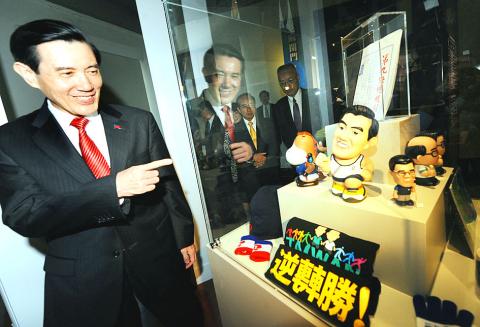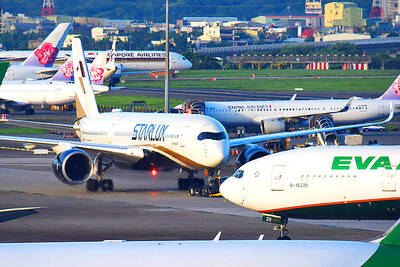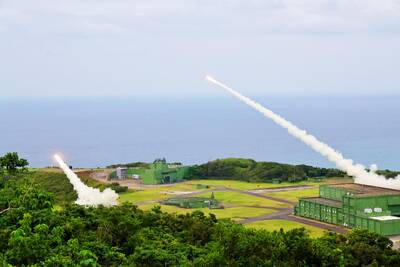“I miss the good old years,” President Ma Ying-jeou (馬英九) said as he looked at pictures of himself at the recently opened Presidential and Vice Presidential Artifacts Museum in Taipei.
The photographs had been taken in the 1970s, when Ma was a secretary and interpreter for then-president Chiang Ching-kuo (蔣經國), son of dictator Chiang Kai-shek (蔣介石).
Academia Historica, a subsidiary of the Presidential Office, manages the museum, which officially opened on Oct. 10.

PHOTO: CNA
Just like the presidential library and museum system in the US, Taiwan’s first Presidential and Vice Presidential Artifacts Museum was established to preserve, educate and inspire Taiwanese about the presidency and what makes Taiwanese a nation.
Academia Historica president Lin Man-houng (林滿紅) said the collection included more than 730,000 photographs, 8,300 documents, 2,200 volumes, about 5,200 audio and video materials and 5,500 artifacts ranging from silver cuff links inlaid with pearls to a 3m long canoe.
Because of space limitations, the exhibits, which are about the president and the Constitution, the president’s oath, the presidential elections, the president and history, the president and coins, the president and expatriates and the presidents’ gifts, will be rotated on a regular basis.
Situated behind the Presidential Office, the four-story museum is housed in an 86-year-old Baroque-style building. Academia Historica, which took ownership of the building from the Ministry of Transportation and Communications in 2006, spent three years and NT$80 million (US$2.6 million) renovating it.
Although the museum was opened on Oct. 10 to coincide with Double Ten National Day celebrations, the final remodeling on the fourth floor is not expected to be completed until March next year.
Lin said the museum opened on Oct. 10 for three reasons.
First was that they wanted the public to gain access to state property as soon as possible. About a quarter of the documents deposited in Academia Historica’s repository in Sindian (新店), Taipei County, have been digitalized and are available to the public at the museum.
Second was that they hoped the opening could help them raise more funds. Despite the additional task of managing the museum, Lin said their budget remained the same. Academia Historica has an annual budget of about NT$240 million.
Third was that they opened the museum to coincide with the 99th anniversary of the founding of the Republic of China (ROC) as part of the year-long celebrations leading to next year’s centennial.
Lin, an historian famous for her theory that the 1952 Treaty of Taipei affirmed the transfer of Taiwan’s sovereignty from Japan to the ROC, impressed Ma so much that the president has made similar remarks on various occasions.
In April last year, Ma said while the 1952 treaty does not specify the legal successor government of Taiwan, “it was clear between the lines.”
Ma’s statement deviated from his previous claim that it was the 1943 Cairo Declaration that gave the ROC its claim to Taiwan. Independence activists, however, doubt the validity of the 1943 declaration, saying it was little more than a press release and cite the 1952 treaty to argue that Taiwan’s international status remains undefined.
Chu Chung-sheng (朱重聖), vice president of Academia Historica, said the term “republic” was a vague concept when Sun Yat-sen (孫中山) overthrew the Qing Dynasty in 1911 and established the republic.
“Sun’s vision was to create a government of the people, by the people and for the people,” Chu said.
Before the ROC was founded, Chinese currencies did not carry the image of a political figure, he said. The first portrait to appear on the ROC currency was Yuan Shikai (袁世凱), who was elected president in 1913, Chu said. Due to the high silver content of the coins during Yuan’s presidency, which were nicknamed “Yuan Da Tou (袁大頭), Chu said it was more valuable than the money featuring Sun. Chiang Kai-shek did not appear on the Taiwanese currency until 1976, Chu said.
With the opening of the museum, Chu said they hoped that not only Taiwanese would get a better understanding of the country, but that Chinese tourists could better appreciate the development of Taiwan.
“Don’t underestimate the impact a museum, such as this one, will have on an individual,” he said. “It can make a difference in the long run.”
In the US, the presidential library system has 13 libraries nationwide to preserve historic materials from presidents since the time of Herbert Hoover.
The Taiwanese legislature passed a law in January 2004 on the management of records, historical materials and artifacts from the presidents and vice presidents. The law is applicable to all former and sitting national leaders.
Although sustainable management tops the museum’s agenda, Chu said they were unlikely to follow the US model to have a nationwide network of libraries and museums, which usually end up as the offices of retired US presidents.
“Taiwan is a very small country and if every president has a museum of their own, the building and maintenance alone will be costly,” he said.
In the long run, Chu said they wanted to open a second museum in Taichung and a third one in Kaohsiung and hopefully, they can begin the detailed planning of the second museum in 2013. However, this depends on the economy and the government’s financial situation, he said.
It turns out that it wasn’t so safe to build the presidential museum close to the Presidential Office, he said, as part of the Presidential Office building was severely damaged during World War II and some adjacent structures were destroyed.
To ensure the safety of the collections, Chu said they stored the original documents in Sindian so some of the items on display are replicas.
What was equally important when choosing a location was to find professionals specializing in museum, library and archive management, he said.
While Taiwan has no shortage of museum and library management experts, Chu said archive management is still in its infancy. Compounding the problem was the different archiving systems practiced by state and local governments, including the Presidential Office, he said.
When former president Chen Shui-bian (陳水扁) left office in 2008, he was accused of taking cartons of state records and was taken to court for illegal possession of state property. The recent ruling on his corruption cases also touched off a heated debate on presidential duties.
Chu said the power of the president has changed over time in Taiwan. When the country was under authoritarian rule, presidential power was decided by the dictator. As Taiwan became more democratic, the president still enjoyed tremendous power, but the Taipei District Court recently ruled that a president’s constitutional power is limited to cross-strait ties, foreign affairs and national defense.
Chu has served both Democratic Progressive Party and KMT administrations. The last thing the museum should do is let politics get in the way when they present history, he said.
“Our mission is to tell the true story of the past,” he said. “Whether or not it is a sensitive political incident such as the Formosa Incident, we shouldn’t care what political parties think. We should just let historical records tell the story.”
Describing himself as a “rebel” in his younger years, Chu said that he drank, smoked and gambled, but as he grew older, he realized that he owed his life to God and that he must tell his personal story to the public.
A survivor of bone marrow cancer, Chu is paralyzed from the waist down and unlikely to be able to walk again.
Lee Bai-hui (李百蕙), a granddaughter of the late artist Li Mei-shu (李梅樹) who won global acclaim for his supervision of the restoration of the Tsu-shih Temple in Sansia (三峽), Taipei County, was excited when she saw a painting of her grandfather hanging at the top of the museum’s stairs going to the second floor.
The 112cm by 145.5cm oil painting is a perennial exhibit at the museum. She was only nine years old when her grandfather painted the portrait of her, her younger brother and younger sister.
The composition of the 1965 painting, entitled Grandchildren, formed the Chinese character shan (山) or “mountain.”
Lee Bai-hui said her grandfather admired Sun so much that he wanted to show his reverence for Sun, who is dubbed the founding father of the ROC.
The painting was completed in 1965, one year before the 100th anniversary of Sun’s birth.

Trips for more than 100,000 international and domestic air travelers could be disrupted as China launches a military exercise around Taiwan today, Taiwan’s Civil Aviation Administration (CAA) said yesterday. The exercise could affect nearly 900 flights scheduled to enter the Taipei Flight Information Region (FIR) during the exercise window, it added. A notice issued by the Chinese Civil Aviation Administration showed there would be seven temporary zones around the Taiwan Strait which would be used for live-fire exercises, lasting from 8am to 6pm today. All aircraft are prohibited from entering during exercise, it says. Taipei FIR has 14 international air routes and

Taiwan lacks effective and cost-efficient armaments to intercept rockets, making the planned “T-Dome” interception system necessary, two experts said on Tuesday. The concerns were raised after China’s military fired two waves of rockets during live-fire drills around Taiwan on Tuesday, part of two-day exercises code-named “Justice Mission 2025.” The first wave involved 17 rockets launched at 9am from Pingtan in China’s Fujian Province, according to Lieutenant General Hsieh Jih-sheng (謝日升) of the Office of the Deputy Chief of the General Staff for Intelligence at the Ministry of National Defense. Those rockets landed 70 nautical miles (129.6km) northeast of Keelung without flying over Taiwan,

The Ministry of National Defense (MND) today released images of the military tracking China’s People's Liberation Army (PLA) movements during the latest round of Chinese drills around Taiwan. The PLA began "Justice Mission 2025" drills today, carrying out live-fire drills, simulated strikes on land and maritime targets, and exercises to blockade the nation's main ports. The exercises are to continue tomorrow, with the PLA announcing sea and air space restrictions for five zones around Taiwan for 10 hours starting from 8:30am. The ministry today released images showing a Chinese J-16 fighter jet tracked by a F-16V Block 20 jet and the

City buses in Taipei and New Taipei City, as well as the Taipei MRT, would on Saturday begin accepting QR code payments from five electronic payment providers, the Taipei Department of Transportation said yesterday. The new option would allow passengers to use the “transportation QR code” feature from EasyWallet, iPass Money, iCash Pay, Jkopay or PXPay Plus. Passengers should open their preferred electronic payment app, select the “transportation code” — not the regular payment code — unlock it, and scan the code at ticket readers or gates, General Planning Division Director-General Liu Kuo-chu (劉國著) said. People should move through the